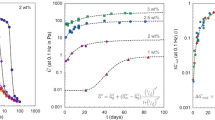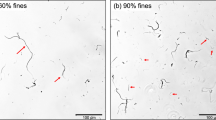Abstract
In this work, nanofibrillated suspensions of bacterial cellulose (BC) were produced via microfluidization. The effects of the size of the openings of the microfluidizer chamber and ultrasonication on the nanofibril properties were evaluated. The results of the X-ray diffraction analysis indicated a considerable reduction in BC crystallinity (86–65%) and crystallite size (5.8–4.0 nm) after microfluidization and ultrasonication. Thermal analysis showed a remarkable reduction from 337 to 283 °C in the initial temperature of degradation along the several steps of BC deconstruction. Moreover, infrared analysis indicated that both processes led to an increase in the Iβ content (43–66%) of the fibers. Morphological analysis showed that the fibrillation process used exposed the internal faces of the ribbon-like nanofibrils, and thus, increased the surface area of the cellulose network, and produced fibers with a high aspect ratio (L/d). A thermally stable nanofibrillated suspension could be obtained by adding carboxymethyl cellulose as a simple and effective way to maintain cellulose fibers dispersed in the solution during sterilization by autoclaving.
Graphical abstract







Similar content being viewed by others
References
Andrade FK, Alexandre N, Amorim I, Gartner F, Maurício AC, Luís AL, Gama M (2013) Studies on the biocompatibility of bacterial cellulose. J Bioact Compat Polym 28(1):97–112
Basta AH, El-Saied H, El-Deftar MM, El-Henawy AA, El-Sheikh HH, Abdel-Shakour EH, Hasanin MS (2016) Properties of modified carboxymethyl cellulose and its use as bioactive compound. Carbohydr Polym 153:641–651
Briois B, Saito T, Pétrier C, Putaux JL, Nishiyama Y, Heux L, Molina-Boisseau S (2013) Iα → Iβ transition of cellulose under ultrasonic radiation. Cellulose 20(2):597–603
Çakar F, Özer I, Aytekin AÖ, Sahin F (2014) Improvement production of bacterial cellulose by semi-continuous process in molasses medium. Carbohydr Polym 106:7–13
Chai MN, Isa MIN (2013) The oleic acid composition effect on the carboxymethyl cellulose based biopolymer electrolyte. J Cryst Process Technol 3:1–4
Dufresne A (2012) Nanocellulose: from nature to high performance tailored materials. Walter de Gruyter Incorporated, Berlin
Gea S, Reynolds CT, Roohpour N, Wirjosentono B, Soykeabkaew N, Bilotti E et al (2011) Investigation into the structural, morphological, mechanical and thermal behaviour of bacterial cellulose after a two-step purification process. Biores Technol 102:9105–9110
Huang Y, Zhu C, Yang J, Nie Y, Chen C, Sun D (2014) Recent advances in bacterial cellulose. Cellulose 21(1):1–30
Jin-shu YANG (2014) Application of sodium carboxymethyl cellulose in food industry. Acad Period Farm Prod Process 22:027
Jonoobi M, Harun J, Shakeri A, Misra M, Oksman K (2009) Chemical composition, crystallinity, and thermal degradation of bleached and unbleached kenaf bast (Hibiscus cannabinus) pulp and nanofibers. BioResources 4(2):626–639
Kargl R, Mohan T, Bračič M, Kulterer M, Doliška A, Stana-Kleinschek K, Ribitsch V (2012) Adsorption of carboxymethyl cellulose on polymer surfaces: evidence of a specific interaction with cellulose. Langmuir 28(31):11440–11447
Khalil HA, Davoudpour Y, Islam MN, Mustapha A, Sudesh K, Dungani R, Jawaid M (2014) Production and modification of nanofibrillated cellulose using various mechanical processes: a review. Carbohydr Polym 99:649–665
Kose R, Mitani I, Kasai W, Kondo T (2011) “Nanocellulose” as a single nanofiber prepared from pellicle secreted by Gluconacetobacter xylinus using aqueous counter collision. Biomacromolecules 12(3):716–720
Ku H, Wang H, Pattarachaiyakoop N, Trada M (2011) A review on the tensile properties of natural fiber reinforced polymer composites. Compos B Eng 42(4):856–873
Kurosumi A, Sasaki C, Yamashita Y, Nakamura Y (2009) Utilization of various fruit juices as carbon source for production of bacterial cellulose by Acetobacter xylinum NBRC 13693. Carbohydr Polym 76(2):333–335
Levdik I, Inshakov MD, Misyurova EP, Nikitin VN (1967) Study of pulp structure by infrared spectroscopy. Tr Vses Nauch Issled Irst Tsellyul Bum Prom 52:109–111
Li M, Wang LJ, Li D, Cheng YL, Adhikari B (2014) Preparation and characterization of cellulose nanofibers from de-pectinated sugar beet pulp. Carbohydr Polym 102:136–143
Li Z, Wang L, Hua J, Jia S, Zhang J, Liu H (2015) Production of nano bacterial cellulose from waste water of candied jujube-processing industry using Acetobacter xylinum. Carbohydr Polym 120:115–119
Liimatainen H, Haavisto S, Haapala A, Niinimaki J (2009) Influence of adsorbed and dissolved carboxymethyl cellulose on fibre suspension dispersing, dewaterability, and fines retention. BioResources 4(1):321–340
Matthews JF, Himmel ME, Crowley MF (2012) Conversion of cellulose Iα to Iβ via a high temperature intermediate (I-HT) and other cellulose phase transformations. Cellulose 19(1):297–306
Mirhosseini H, Tan CP, Hamid NS, Yusof S (2008) Effect of Arabic gum, xanthan gum and orange oil contents on ζ-potential, conductivity, stability, size index and pH of orange beverage emulsion. Colloids Surf A 315(1):47–56
Molina-Ramírez C, Castro C, Zuluaga R, Gañán P (2017) Physical characterization of bacterial cellulose produced by komagataeibacter medellinensis using food supply chain waste and agricultural by-products as alternative low-cost feedstocks. J Polym Environ 26(2):830–837
Nascimento ES, Lima HLS, Barroso MKA, Brígida AIS, Andrade FK, Borges MF, Morais JPS, Muniz CR, Rosa MF (2016) Mesquite (Prosopis juliflora (Sw.)) extract is an alternative nutrient source for bacterial cellulose production. J Biobased Mater Bioenergy 10(1):63–70
Nelson ML, O’Connor RT (1964) Relation of certain infrared bands to cellulose crystallinity and crystal lattice type. Part II. A new infrared ratio for estimation of crystallinity in cellulose I and II. J Appl Polym Sci 8:1325–1341
Noltingk BE, Neppiras EA (1950) Cavitation produced by ultrasonics. Proc Phys Soc B63:674–685
Pecoraro E, Manzani D, Messaddeq Y, Ribeiro SJ (2008) Bacterial cellulose from Glucanacetobacter xylinus: preparation, properties and applications. In: Belgacem MN, Gandini A (eds) Monomers, polymers and composites from renewable resources. Elsevier, Oxford, p 369
Qing Y, Sabo R, Zhu JY, Agarwal U, Cai Z, Wu Y (2013) A comparative study of cellulose nanofibrils disintegrated via multiple processing approaches. Carbohydr Polym 97:226–234
Ramli NA, Wong TW (2011) Sodium carboxymethylcellulose scaffolds and their physicochemical effects on partial thickness wound healing. Int J Pharm 403(1):73–82
Sakurada I, Nukushina Y, Ito T (1962) Experimental determination of the elastic modulus of crystalline regions in oriented polymers. J Polym Sci Part A Polym Chem 57(165):651–660
Segal L, Creely J, Martin A, Conrad C (1959) An empirical method for estimating the degree of crystallinity of native cellulose using the X-ray diffractometer. Text Res J 29:786–794
Sulaeva I, Henniges U, Rosenau T, Potthast A (2015) Bacterial cellulose as a material for wound treatment: properties and modifications: a review. Biotechnol Adv 33(8):1547–1571
Szymańska-Chargot M, Cybulska J, Zdunek A (2011) Sensing the structural differences in cellulose from apple and bacterial cell wall materials by Raman and FT-IR spectroscopy. Sensors 11(6):5543–5560
Tonoli GHD, Teixeira EM, Corrêa AC, Marconcini JM, Caixeta LA, Pereira-da-Silva MA, Mattoso LHC (2012) Cellulose micro/nanofibres from Eucalyptus kraft pulp: preparation and properties. Carbohydr Polym 89(1):80–88
Tsalagkas D, Dimic-Misic K, Gane P, Rojas OJ, Maloney T, Csoka L (2015) Rheological behaviour of sonochemically prepared bacterial cellulose aqueous dispersions. In: 6th International symposium on industrial engineering (SIE 2015), Belgrade, serbia
Ullah H, Badshah M, Mäkilä E, Salonen J, Shahbazi MA, Santos HA, Khan T (2017) Fabrication, characterization and evaluation of bacterial cellulose-based capsule shells for oral drug delivery. Cellulose 24(3):1445–1454
Vanhatalo K, Lundin T, Koskimäki A, Lillandt M, Dahl O (2016) Microcrystalline cellulose property–structure effects in high-pressure fluidization: microfibril characteristics. J Mater Sci 51(12):6019–6034
Vasconcelos NF, Feitosa JPA, da Gama FMP, Morais JPS, Andrade FK, de Souza MDSM, de Freitas Rosa M (2017) Bacterial cellulose nanocrystals produced under different hydrolysis conditions: properties and morphological features. Carbohydr Polym 155:425–431
Wada M, Kondo T, Okano T (2003) Thermally induced crystal transformation from cellulose Iα to Iβ. Polym J 35(2):155–159
Wada M, Hori R, Kim UJ, Sasaki S (2010) X-ray diffraction study on the thermal expansion behavior of cellulose Iβ and its high-temperature phase. Polym Degrad Stab 95(8):1330–1334
Wang Y, Lian J, Wan J, Ma Y, Zhang Y (2015) A supramolecular structure insight for conversion property of cellulose in hot compressed water: polymorphs and hydrogen bonds changes. Carbohydr Polym 133:94–103
Yadollahi M, Namazi H (2013) Synthesis and characterization of carboxymethyl cellulose/layered double hydroxide nanocomposites. J Nanopart Res 15(4):1–9
Yin N, Stilwell MD, Santos TMA, Wang H, Weibel DB (2015) Agarose particle-templated porous bacterial cellulose and its application in cartilage growth in vitro. Acta Biomater 12:129–138
Zemljič LF, Steniusb P, Laineb J, Stana-Kleinscheka K, Ribitschc V (2006) Characterization of cotton fibres modified by carboxymethyl cellulose. Lenzing Berichte 85:68–76
Acknowledgments
The authors wish to acknowledge the financial support provided by the Coordination for the Improvement of Higher Education Personnel (CAPES, Brazil), the National Counsel of Technological and Scientific Development (CNPq, Brazil), the Foundation for Science and Technology (FCT, Portugal), and also the Embrapa Tropical Agroindustry. This research study was also supported by the international collaboration Program FCT/CAPES (No. 99999.008530/2014-09).
Author information
Authors and Affiliations
Corresponding author
Additional information
Publisher's Note
Springer Nature remains neutral with regard to jurisdictional claims in published maps and institutional affiliations.
Electronic supplementary material
Below is the link to the electronic supplementary material.
Rights and permissions
About this article
Cite this article
Andrade, F.K., Morais, J.P.S., Muniz, C.R. et al. Stable microfluidized bacterial cellulose suspension. Cellulose 26, 5851–5864 (2019). https://doi.org/10.1007/s10570-019-02512-y
Received:
Accepted:
Published:
Issue Date:
DOI: https://doi.org/10.1007/s10570-019-02512-y




